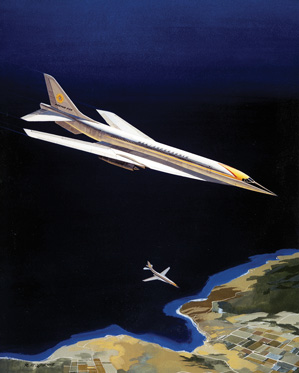The Man Who Grounded the Boeing SST
In the late 1960s, the whole country had its head in the clouds. Supersonic planes were going to take us, in the words of John F. Kennedy, “to all corners of the globe” and then straight into the future. The Boeing supersonic transport (SST), commissioned by the U.S. government in 1966, was to lead the way. The American answer to the Anglo-French Concorde, the Boeing SST would have been the quickest thing on two wings.

But all that speed meant noise for those on the ground. When an aircraft breaks the sound barrier, it pushes the air in front of it away so forcefully that a high-pressure shock wave is created. If this shock wave passes over you, you hear a loud “boom”—just as we hear thunder after lightning causes sudden air-pressure changes. Because an SST outpaces sound for its entire journey, it creates not just one thunderclap but a whole “boom carpet” that unfurls continuously behind it.
When William Shurcliff pictured an SST, he imagined not the great swell of progress but this startling aftermath. Shurcliff—an accomplished physicist with 40 papers and a dozen patents under his belt—considered himself “a very shy fellow.” He was a senior research associate at the Cambridge Electron Accelerator, which was jointly run by MIT and Harvard. But he had also been a technical aide on the Manhattan Project, and he understood what happens when people fail to anticipate the unintended consequences of scientific progress.
In 1966, spurred by this wariness, and by what he called the “whitewashed,” “sugarcoated” science he found in reports commissioned by the Federal Aviation Administration, Shurcliff began writing letters to the authors of the FAA reports, saying he feared the end of “a golden era in the U.S. … when a man’s home was a place where he could live quietly.” He wrote to the Civil Aeronautics Board (“I take my sleep seriously”), to dozens of congressmen, and to citizens who shared his concerns. Shurcliff asked whether his correspondents knew of any national groups that aimed to “attack the sonic boom threat vigorously.” “I want to give a lot of money to such a group,” he explained—money, more of his time, and the information he had amassed from sheaves of studies, reports, and correspondence.
It became clear that the man for the job was Shurcliff himself. In February 1967, his “fairly intense one-man campaign against the SST” went public and became the Citizens League Against the Sonic Boom (CLASB for short). Thus was born one of the more successful grassroots environmental movements in U.S. history.
CLASB meetings were held in the Shurcliff residence, at 19 Appleton Street in Cambridge; the first, in March 1967, drew 13 members, all correspondents and colleagues of Shurcliff’s. By the second meeting, the group had opened a checking account to deal with donations; by the fifth, it was hiring secretaries. CLASB volunteers worked tirelessly, producing newsletters, fact sheets, “sonic-boom bang-zone maps,” letters to various editors, and an 80-page SST handbook. Members appeared on radio and television, and Shurcliff testified in front of President Nixon’s ad hoc SST committee.
Even as he expanded his efforts, Shurcliff stuck to his strengths—speed, thoroughness, and follow-through, sweetened by a “personal touch.” Take, for example, CLASB’s 1969 campaign to win over the boating public. Someone brought up yachtsmen in a May meeting; by June, CLASB had mailed specially targeted anti-SST letters and petition cards to all 800 members of the Cruising Club of America, warning that their beloved coastal waters could soon become “a vast dumping-ground for sonic booms.” As of July 10, the group had gathered over 100 signatures, and a week later it had drafted a letter to President Nixon, as well as a press release. CLASB ran similar campaigns to attract conservation organizations, anti-noise groups, and mink farmers, among others.
Despite predictions in the original CLASB proposal, Shurcliff never found “somebody else to take on the main load,” and CLASB never left its “temporary” office on Appleton Street. But when Congress voted to defund the Boeing SST in 1971—a vote spurred partially by, in the words of Time magazine, “a sizable citizens’ army of environmentalists”—over 5,000 CLASB members let out a quiet, respectful whoop.
Keep Reading
Most Popular
Large language models can do jaw-dropping things. But nobody knows exactly why.
And that's a problem. Figuring it out is one of the biggest scientific puzzles of our time and a crucial step towards controlling more powerful future models.
How scientists traced a mysterious covid case back to six toilets
When wastewater surveillance turns into a hunt for a single infected individual, the ethics get tricky.
The problem with plug-in hybrids? Their drivers.
Plug-in hybrids are often sold as a transition to EVs, but new data from Europe shows we’re still underestimating the emissions they produce.
Google DeepMind’s new generative model makes Super Mario–like games from scratch
Genie learns how to control games by watching hours and hours of video. It could help train next-gen robots too.
Stay connected
Get the latest updates from
MIT Technology Review
Discover special offers, top stories, upcoming events, and more.